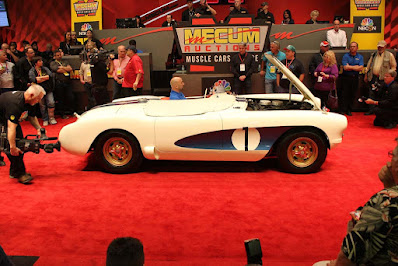Just about anybody in the world who knows a little about cars knows that the Corvette was the first American sports car and is now the most popular, fastest, and most recognizable American sports car to date. But what a lot of people may not know is that this was not always true. In fact, by the year 1955, the Corvette almost saw its extinction.
Rumors about the move to drop the Corvette flooded out of Chevrolet's top offices with very sad sales numbers to back up what only seemed to be a good idea. Their competition, the two-seater Ford Thunderbird, which sold an astonishing 16,000 units in 1955—the Corvette—only sold a depressing 700 units.
Unfortunately for Ford, the same car that was taking so many sales away from the Corvette would be the inspiration for keeping the Corvette in the product lineup. The idea behind keeping the Vette and spending more money on a car that was obviously tanking was brought on by a few Chevrolet bigwigs, including former Corvette chief engineer Dave McLellan. McLellan released a statement concurring that, "if the Ford Thunderbird was doing so well, there is obviously a market for a two-seater sports car. With a solid change for the better and the right amount of marketing, the Corvette should be able to become a moneymaker."
In an ironic twist, the very car that Corvette planned to piggyback off of, the Ford Thunderbird, had already made future plans to market the car differently by doing away with the two-seater style and making it a four-seater touring car, thus leaving the American sports car market wide open for Chevrolet and its Corvette.
"The Real McCoy"
As wide open as the market was, the Corvette needed some changes for success, ideally in the form of performance and a new body style. When Zora Arkus Dutov took the reins as Corvette Chief Engineer, he was ready to make those changes, but he knew first the chassis had to be redesigned to handle any horsepower upgrades.
Once engineers updated and strengthen the chassis, Chevrolet engineers went performance and horsepower hunting. First, they ditched the boring and heavy two-speed power-glide transmission and replaced it with an upgraded four-speed. They also took the original 265 cu.-in. motor and bored it out to a 307 that sported dual Cater carbs and a now-famous "Dutov High-Performance Cam."
Other upgrades were also included on the Real McCoy like a very rare set of Halibrand magnesium knock-off wheels, special heavy-duty brakes with cooling scoops, heavy-duty shocks and sway bars, an upgraded high-capacity fuel tank, and more—all newly implicated to help achieve the Corvette performance desired.
After all of those upgrades, top engineers slapped a new SR Prototype body on what was now known as project Corvette #6901. The engineers called it "The Real McCoy" and decided it was ready to head to the racetrack.
Dayton Speedway Record
The first stop for the "Real McCoy" was the Dayton Speed Week for a two-way flying speed mile. This is where the Corvette would make its first milestone. At the time, the record for the Corvettes class was 127 mph. With Dutov as the driver, the 255-horsepower Corvette sped to an average speed of 150.58mph to crush the record.
This was an extremely sufficient record because it occurred just weeks before the New York Motorama, where the Corvette would be on display to many potential buyers, most of which had already heard the news of the record-breaking performance.
12-Hour Sebring Race
A few months after Daytona, the ground-breaking Corvette made its way to the famous 12-Hour Sebring Race. This race was designed only for the toughest of the toughest—the fastest of the fastest. Only cars like Jaguars, Bentleys, and Aston Martins graced the racetracks for these events. But with a chance to prove that the Corvette has changed and deserved respect along with the other powerful sports cars, Chevrolet did not shy away, instead, they joined in on the action.
Race car drivers John Fitch and Walter Hansgen were brought on board to take on the challenging race. When the green flag dropped, the race was on. But early on in the race, the Corvette experienced mechanical problems, so much so they did not think it would finish the race. In the end, not only did the Real McCoy Corvette finish, the Corvette finished first in its respective class and 9th overall. This was an incredible accomplishment, especially considering 60 cars entered the event, but only 24 crossed the finish line.
With another huge milestone under Corvette's belt, Chevrolet exploited it by printing ads like this "A Tough, Road-Gripping Torpedo On Wheels" and "The Most Remarkable Car Made In America Today."
Those ads were to send a message: Corvette had finally arrived as a force in the international sportscar racing circuits, and they proudly called this particular Vette "The Real McCoy."
Between all of its accomplishments and Chevrolet's ad campaigns, the '56 Corvette sold 3,467 units, and in '57 they nearly doubled that with 6,339 sold. One of the main reasons the Corvette saw such selling success was if they were to race the Vette in its respected class at the 12-hour Sebring race, every part that was changed or modified for the race had to be documented and later made available to the public. This process made potential buyers very excited about being able to buy a Corvette and beef it up to run and look just like the “The Real McCoy”
In any event, if it was not for the #6901 '56 PJ Prototype "Real McCoy" Corvette, and possibly the success of the Thunderbird, Chevrolet may have never gone forward with the Corvette and, the automobile industry would definitely not be the same today.




